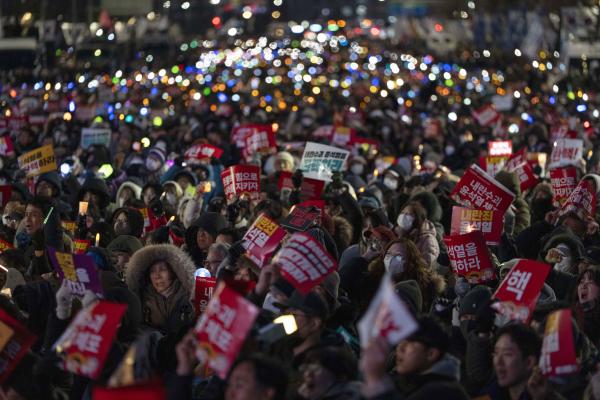
Hundreds of thousands of people from all walks of life defied the military to protest the declaration of martial law by South Korean President Yoon Suk Yeol, December 7, 2024. Photo: AP
At 11:00 p.m. (Korea time) on December 3, South Korea’s warmongering, hard-core reactionary president, Yoon Suk Yeol, declared martial law. He called out the military to enforce a ban on free speech, protest, and even mainstream media broadcasts. He declared that he had to do that to stop "the threat of North Korean communist forces" and "to eradicate the despicable pro-North Korean anti-state forces that are plundering the freedom and happiness of our people."
Helmeted troops and police surrounded the National Assembly (parliament) building. Helicopters were deployed on the roof. Local media showed scenes of masked, gun-toting troops attempting to enter the National Assembly while civilian assembly staffers mobilized to hold them off with fire extinguishers.
By the end of the day, hundreds of thousands of people from all walks of life defied the military to protest. They filled the streets of Seoul, South Korea’s capital, in freezing weather. Protesters chanted “No martial law!" and "Strike down dictatorship!" They defied threats to use the military to stop them. And they weren’t immobilized by the fact that while Yoon is deeply hated by large sections of people in South Korea, he is the elected president of the country.
On the next day, December 4, Yoon backed down and rescinded martial law. He announced in a nationally televised address, “I am very sorry and would like to sincerely apologize to the people who were shocked.”
Nobody knows where this will all end up. Opposition ruling class parties in the South Korean National Assembly failed to get enough votes to impeach Yoon. But this outpouring was a welcome event, with people in their hundreds of thousands rising up to, so far, prevent a self-coup that would have imposed draconian, fascistic martial law.
And this happened in a country the rulers of the United States have built up into an economic capitalist-imperialist power (world’s 10th largest economy), a military counter to North Korea, Russia, and China, and a model of the “free world.”
Seemingly Out of Nowhere, but… Not Really
The U.S. rulers tout South Korea as a model of the “free world.” They built up South Korea as a capitalist-imperialist “success story” with prosperity (for some), limited but officially free speech for sections of the population, and a massive military.
This buildup in South Korea was preceded by over 40 years of extremely brutal oppression and super-exploitation carried out by the U.S., and a bloody military dictatorship (see accompanying box). During the 1950s and ’60s, Korean women driven into prostitution by all this were literally displayed in windows as if they were so much raw meat for occupying American soldiers to consume. (This is graphically and horrifically depicted in Nora Okja’s award-winning novel Fox Girl.)
In 1991, the Soviet Union collapsed and the U.S. was able to greatly expand its share of the global plunder. At that time, the rulers of the U.S. found it both useful and necessary to cut South Korea in as a “junior partner” in Asia; U.S. imperialism had the ability to “allow” South Korea to institute certain bourgeois-democratic institutions that included greater personal rights and parliamentary rule, with power peacefully transferred between competing capitalist-imperialist parties.
But South Korean society continues to be riven with social, gender, and economic divisions. Its ruling class has differences over how to handle being on the “front line” of the global conflict between U.S. imperialism and nuclear-armed (and in a different style, capitalist) North Korea and its Russian and Chinese imperialist backers. All these contradictions had been bottled up.
The declaration of martial law tore up what for decades has been the “normal way things are supposed to work” in a capitalist-imperialist democracy like South Korea. It let a genie out of a bottle. It brought hundreds of thousands into the streets. And in 24 hours, in what on the surface was a stable South Korea, ruled by a hard-core reactionary, things changed literally overnight!
We don't know where things are going to go from here, but what has happened so far is significant, inspiring, and something to learn from. The situation in South Korea bears serious watching and reflection by all those who reject fascist rule in the U.S. and are determined to prevent its full imposition.
Background on South Korea
After World War 2, the U.S. massively intervened in the Korean War between the north, which was aligned with what were then socialist countries in Russia and China, and pro-U.S. forces in the south. The U.S. unleashed the most horrific death and destruction on all of Korea, including mass murder of millions, carpet bombing the entire country into rubble, use of chemical weapons against civilians, repeatedly threatening use of nuclear weapons, and wholesale rape of women.
The Korean War was fought to a standstill, which was a setback for the U.S. which aimed to push all the way into (what was then, but no longer is) a socialist China. Korea remained divided into north and south. Along with building up South Korea economically, the U.S. imposed a series of brutal, torture-chamber military rulers on South Korea as a bulwark against communism and the national liberation struggles that were sweeping Asia, Africa, Latin America, and the Middle East.
From May 18-27, 1980 the U.S.-backed South Korean military junta of President Chun Doo Hwan massacred as many as 2,000 courageous protesters in the major city of Kwangju. This and other violent repression, largely orchestrated by the U.S., failed to crush the spirit and determination of people in South Korea to end the fascist regime. By the end of the 1980s, the U.S. and their South Korean allies found it necessary and expedient to institute bourgeois democratic elections, and—overall—a practice of peaceful transfer of power between contending sections of the South Korean ruling class and their social bases through elections.